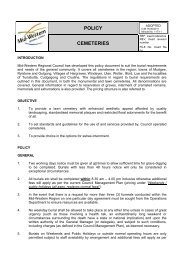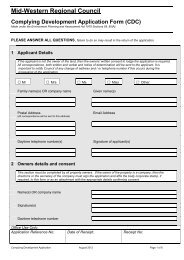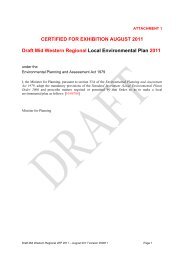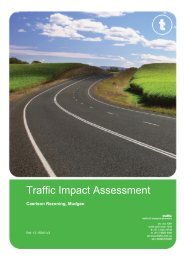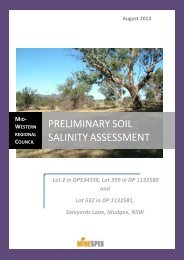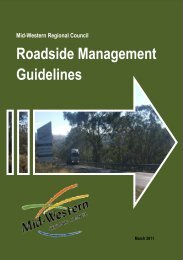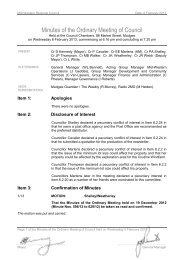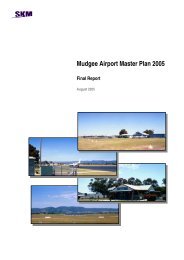3000 kb - Mid Western Regional Council - NSW Government
3000 kb - Mid Western Regional Council - NSW Government
3000 kb - Mid Western Regional Council - NSW Government
Create successful ePaper yourself
Turn your PDF publications into a flip-book with our unique Google optimized e-Paper software.
charges. Where capital works costs are low and cash levels are high this may be possible<br />
but it may also suggest that current levels of charging are too high.<br />
On the other hand deferring expenditure is consistent with the goal of inter-generational<br />
equity when considering long-term asset management. Longer period loans spread the<br />
cost of works over a longer period, eliminating early peaks in annual charges. Often<br />
councils will have no choice except to borrow for major projects because collecting<br />
sufficient cash in advance is impracticable and would require an unacceptably high level<br />
of charges.<br />
In general most councils use a mix of revenue and borrowings to meet <strong>Council</strong>’s financial<br />
performance policy criteria. Given that this is achieved, the latest DEUS Guidelines<br />
recommend adoption of the lowest possible steady rate of long-term charges in real terms<br />
that is achievable. In the Phase 1 runs of the model the default loan period used was<br />
twenty years.<br />
Phase 2 – Preferred model and sensitivity<br />
After consideration of Phase1 issues a preferred option will be finally reviewed and<br />
updated to suit any last minute planning refinements and detailed cost estimating carried<br />
out.<br />
While the preferred model reflects the expected performance of the systems, it does not<br />
give any indication of the sensitivity of the proposed solution should the basic<br />
assumptions used prove significantly different in practice.<br />
It is recommended that a sensitivity analysis be carried out if it is perceived that a variable<br />
may change significantly in the future. The value of a sensitivity analysis is that it shows:<br />
• the sensitivity of the results to assumptions (uncontrollable variables)<br />
• the impact of changing controllable variables.<br />
The guidelines suggest that a number of sensitivities be carried out to test the robustness<br />
of the plan. In regard to controllable variables such as type of loan structure, level of<br />
developer charges etc., the model enables <strong>Council</strong> to make decisions to establish the<br />
right management policies.<br />
It is important to demonstrate the impact of the ‘no subsidy’ scenario, which shows the<br />
potential benefits of government assistance. <strong>Council</strong>’s expectations for receiving subsidy<br />
are included in the final preferred model as being the most realistic future scenario.<br />
With uncontrollable variables, <strong>Council</strong> is at the mercy of change. The downside risk of an<br />
increase in interest rates, or low growth rates, or rise in energy costs, may be<br />
considerable. Increasingly the impact of water demand management may be felt in the<br />
future and expected water savings although resulting in loss of revenues, should be more<br />
than compensated for by deferment of capital works and lower operational costs.<br />
On-going Review<br />
Over time, changes in model variables can have a significant impact on the model’s<br />
accuracy and this has implications for <strong>Council</strong>’s forward planning. It is recommended that<br />
the models be revisited regularly to ensure that they retain their currency. Where <strong>Council</strong><br />
has an active capital works program requiring subsidy then annual updates are<br />
recommended.<br />
<strong>Mid</strong>-<strong>Western</strong> <strong>Regional</strong> <strong>Council</strong> Part C - Detailed Information Page 83<br />
Strategic Business Plan for Sewerage



